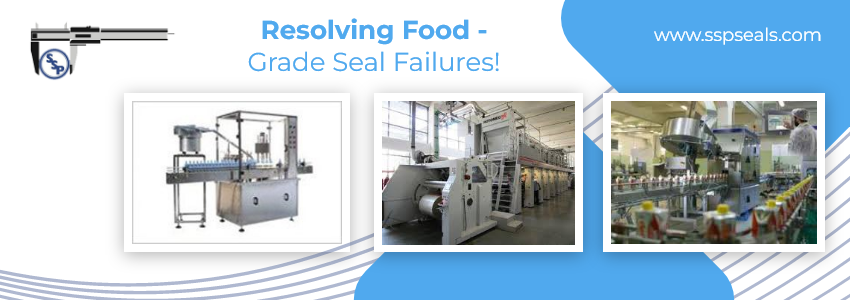Typical Food-Grade Seal Failures and Strategies for Resolution
Nov 22, 2023 Food Grade Seals | Gaskets
Maintaining hygiene, product integrity, and safety is essential in the
food processing industry. Seals and gaskets play an essential role in accomplishing these objectives. They help keep the equipment airtight, prevent cross-contamination, and maintain the hygiene and quality of food products. Unlike many other
industrial seals and gaskets, much consideration goes into their design and manufacturing. Despite these considerations, gasket and seal failures are quite common. If that occurs, the consequences are severe, ranging from contamination to product recalls to fines and revoking food licenses in extreme cases. This post focuses on the common symptoms of failure of gaskets and seals in food processing equipment and offers solutions for their maintenance and prevention.

Identifying and Preventing Failure Modes in Food Grade Applications
Below are some typical symptoms food grade seal failure along with their mitigation tips.
- Leakage: This is one of the most visible signs of gasket and seal failure in the food processing industry. If not addressed timely, it can lead to product contamination, loss of valuable ingredients, and safety hazards. The leaks usually occur if the seals and gaskets are damaged or misaligned.
Maintenance and Prevention: Inspect the food-grade seals and gaskets to identify leakage. Regular inspection would help to identify any such instances immediately. The operator of the processing equipment must be trained to identify signs of leaks around the equipment. If any such damage is detected, immediate replacement must be done to prevent leakage. You can avoid the chances of leakage by following the manufacturer’s installation instructions.
- Degradation: Wear and tear are early signs of food-grade seal and gasket failure. Chemicals, such as sanitizers and cleaning agents, usually bring this degradation. It affects the sealing properties of seals and introduce cross contamination, which often goes undetected.
Maintenance and Prevention: These are made from food grade materials, they may still fail. Inspect the seals for signs of wear and tear. Always choose the seal materials that can resist chemicals and substances they will come in contact with.
- Brittleness: Gaskets and seals may look brittle or lose elasticity and fail to maintain their sealing capacities. This is mainly due to temperature extremes because food processing is performed at high heat or zero temperatures.
Maintenance and Prevention: Although brittle seals and gaskets may not be easily visible, a periodic maintenance program will help you identify them easily. It is always recommended to choose the gasket materials for the rated temperature range of the application. Ensure to protect or insulate the gaskets and seals from extreme temperatures when required.
- Microbial Growth and Contamination: This may not be easily visible; however, close inspections would help you identify them easily. This mainly occurs when oversized or undersized seals are used. They trap food particles, leading to contamination and microbial growth.
Maintenance and Prevention: Choose food quality seals and gaskets with hygienic designs. Custom seals for food industry would help minimize crevices where food particles accumulate. In addition to this, you can implement thorough sanitization and cleaning procedures, and check in high risk areas, too.
- Deformation: The food-grade seals would look permanently deformed and sometimes the gasket will take the shape of the housing. Sometimes, it would go to its original shape when the load is removed. If doesn’t happen, perhaps your seal is affected by compression set.
Maintenance and Prevention: It is always better to choose food grade rubber seals with excellent compression set properties to avoid this type of failure. For instance, silicone is one such material not affected by compression set.
- Extrusion and Nibbling: The gasket looks nibbled or frayed and extrudes from the gland where it is installed. This generally happens when the gland is overfilled. Thus, it is important to fill it only up to 80-90%.
Maintenance and Prevention: The solution to this problem lies in seal design. Investing in good quality custom seals for food industry helps avoid this problem. Always remember that the gland must be larger than the seal. Changing the gasket width is one of the best ways to overfill the gland.
- Pock Marking: This is a common sign of installation damage. You can see the large notches on the seal surface are missing if it is not installed properly. Generally, installation problems can arise due to two reasons – overstretching of the material during installation and rough surfaces of the enclosure.
Maintenance and Prevention: Regular inspections will help easily identify pockmarking. It is always recommended to avoid stretching the seal beyond 50% of its original diameter. Also, the seal edges must be laid carefully and sharp materials should be avoided for scrapping or installation. Adding lead-ins or chamfers on housing would help ease this issue.

The above discussed are only a few common signs of failure of food-grade seals and gaskets. However, many of these failure causes can be easily avoided through regular inspection, meticulous design and engineering. The latter can be easily achieved by partnering with an experienced seal and gasket manufacturer such as SSP Seals. The company provides food-grade seals and gaskets in
custom specifications. You can
contact the experts at the company with your requirements and doubts today.
Related Post
 sales:
gm@sspseals.com
Toll Free: +1-888-238-SEAL Request A Quote
sales:
gm@sspseals.com
Toll Free: +1-888-238-SEAL Request A Quote
